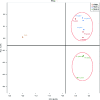Electricity production and the analysis of the anode microbial community in a constructed wetland-microbial fuel cell
- PMID: 35521306
- PMCID: PMC9066182
- DOI: 10.1039/c8ra10130b
Electricity production and the analysis of the anode microbial community in a constructed wetland-microbial fuel cell
Abstract
The objective of this study is to assess bioelectricity generation, pollutant removal (COD, ammonium, nitrate) and the bacterial communities on anodes in constructed wetlands coupled with microbial fuel cells (CW-MFCs), through feeding the systems with three different types of synthetic wastewater (system 1: normal wastewater; system 2: ammonium-free wastewater; system 3: nitrate-free wastewater). Three CW-MFCs were operated with different wastewater concentrations and hydraulic retention times (HRTs) over a long time period (6 months). The results indicate that the maximum open circuit voltage (775.63 mV) and maximum power density (0.628 W m-3) were observed in system 3 (period 3), and that bioenergy production was inhibited in system 2, when feeding with ammonium-free wastewater continuously. COD removal rates in the three systems were similar during each period and ranged from 82.2 ± 6.8% to 98.3 ± 2.2%. Ammonium removal occurred at the air cathode of the CW-MFCs through nitrification, and a higher level of ammonium removal was found in system 1 (period 3) compared with the others. Meanwhile, denitrification occurred at the anaerobic anode of the CW-MFCs, and a large amount of nitrate was removed effectively. The highest nitrate removal rate was 98.8 ± 0.5% in system 2 (period 3). Additionally, four genera related to electricity generation were detected at the anode: Geothrix; Desulfovibrio; Desulfobulbus; and Geobacter. The relative abundances of Desulfovibrio, Desulfobulbus and Geothrix gradually increased during the three periods in system 3, which might be beneficial for bioelectricity generation. Further investigations are needed to optimize the CW-MFC performance and explain the mechanism behind the pollutant degradation and electron motion in the CW-MFCs.
This journal is © The Royal Society of Chemistry.
Conflict of interest statement
There are no conflicts to declare.
Figures





Similar articles
-
Constructed wetlands combined with microbial fuel cells (CW-MFCs) as a sustainable technology for leachate treatment and power generation.RSC Adv. 2024 Oct 11;14(44):32073-32100. doi: 10.1039/d4ra04658g. eCollection 2024 Oct 9. RSC Adv. 2024. PMID: 39399250 Free PMC article. Review.
-
Contaminants removal and bacterial activity enhancement along the flow path of constructed wetland microbial fuel cells.Sci Total Environ. 2019 Feb 20;652:1195-1208. doi: 10.1016/j.scitotenv.2018.10.234. Epub 2018 Oct 18. Sci Total Environ. 2019. PMID: 30586806
-
Electricity production from Azo dye wastewater using a microbial fuel cell coupled constructed wetland operating under different operating conditions.Biosens Bioelectron. 2015 Jun 15;68:135-141. doi: 10.1016/j.bios.2014.12.047. Epub 2014 Dec 23. Biosens Bioelectron. 2015. PMID: 25562740
-
CH4 control and associated microbial process from constructed wetland (CW) by microbial fuel cells (MFC).J Environ Manage. 2020 Apr 15;260:110071. doi: 10.1016/j.jenvman.2020.110071. Epub 2020 Jan 25. J Environ Manage. 2020. PMID: 32090814
-
Microbial phyto-power systems - A sustainable integration of phytoremediation and microbial fuel cells.Bioelectrochemistry. 2019 Jun;127:1-11. doi: 10.1016/j.bioelechem.2018.12.005. Epub 2018 Dec 28. Bioelectrochemistry. 2019. PMID: 30614442 Review.
Cited by
-
Progress and Prospects of Bioelectrochemical Systems: Electron Transfer and Its Applications in the Microbial Metabolism.Front Bioeng Biotechnol. 2020 Jan 31;8:10. doi: 10.3389/fbioe.2020.00010. eCollection 2020. Front Bioeng Biotechnol. 2020. PMID: 32083069 Free PMC article. Review.
-
Removal of Cr(vi) and p-chlorophenol and generation of electricity using constructed wetland-microbial fuel cells based on Leersia hexandra Swartz: p-chlorophenol concentration and hydraulic retention time effects.RSC Adv. 2022 May 17;12(24):15123-15132. doi: 10.1039/d2ra01828d. eCollection 2022 May 17. RSC Adv. 2022. PMID: 35702437 Free PMC article.
-
Constructed wetlands combined with microbial fuel cells (CW-MFCs) as a sustainable technology for leachate treatment and power generation.RSC Adv. 2024 Oct 11;14(44):32073-32100. doi: 10.1039/d4ra04658g. eCollection 2024 Oct 9. RSC Adv. 2024. PMID: 39399250 Free PMC article. Review.
-
Effects of Hydraulic Retention Time on Removal of Cr (VI) and p-Chlorophenol and Electricity Generation in L. hexandra-Planted Constructed Wetland-Microbial Fuel Cell.Molecules. 2024 Oct 9;29(19):4773. doi: 10.3390/molecules29194773. Molecules. 2024. PMID: 39407701 Free PMC article.
-
Effects of biofilm transfer and electron mediators transfer on Klebsiella quasipneumoniae sp. 203 electricity generation performance in MFCs.Biotechnol Biofuels. 2020 Sep 21;13:162. doi: 10.1186/s13068-020-01800-1. eCollection 2020. Biotechnol Biofuels. 2020. PMID: 32973923 Free PMC article.
References
-
- Yadav A. K. Dash P. Mohanty A. Abbassi R. Mishra B. K. Ecol. Eng. 2012;47:126–131. doi: 10.1016/j.ecoleng.2012.06.029. - DOI
LinkOut - more resources
Full Text Sources

